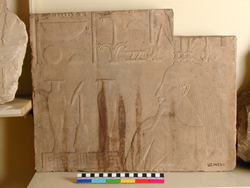
The Hymn to the Nile flood
The longest surviving hymn to the Nile flood is a literary composition in Middle Egyptian, of uncertain date. All surviving copies were written in the New Kingdom (about 1550-1069 BC), and some scholars have argued that it was composed in the New Kingdom. However the style of language and echoes of other literary compositions, such as laments of the order overturned, suggest that it may date to the Middle Kingdom (about 2025-1700 BC). No author is named on the surviving sources.
The Nile flood, named Hapy in Egyptian, was the central event of the agricultural year in the Nile Valley, depositing fine silt from the south over the fields flooded. There is no surviving temple dedicated to the Nile flood, though there might once have been such a cult centre at the place named Per-Hapy 'domain of the Nile flood'. Instead, other written sources refer to festivals at which great quantities of produce were offered to the flood. Possibly, such a festival could have included occasions for the singing of this hymn. However, none of the surviving copies includes directions or dates, and the extracts point rather to a literary appreciation of reading or recital of the composition.
 |
Copyright © 2002 University College London. All rights reserved.